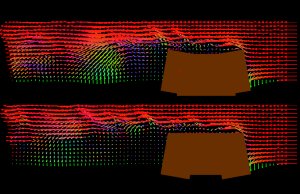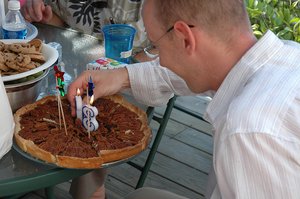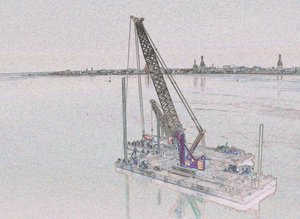The Bridge Blog
A dialog about our new bridge and these web pages
Overview. As a pointy-headed
university professor, my weekend project of bridge photography and
building these web pages generated many questions and introduced me
to just-in-time learning. I enjoy chasing my curiosity and
want to identify ways to encourage younger learners to also enjoy curiosity
chasing and learning.
Learning usually requires repetition while forgetting occurs when
I infrequently use information. Many young learners do not understand
the importance of repetition. Weekly visits to the bridge provided
the repetition necessary to detect changes in the bridge and
consequently generated
many questions and opportunities for learning. Over the course of the
bridge project, I had access to few experts for answering questions.
Rather than a liability, this became an asset and pushed me to improve
my search skills with Google. Soon, I found that answers
to questions encountered during my weekly photo shoots were often
only a Google-search away -
(see
Restoring the Joy in Learning). Consequently Google + Internet became
dependable extensions of my memory.
The bridge story is a work in progress and is evolving from a simple
collections of photographs to an experiment with Internet-centric
just-in-time learning.
Insights I gain from you
will find their way into the learning centers of MUSC.
Palmetto Bridge Constructors, a joint venture between
Tidewater
Skanska and
Flatiron Constructors, as well as
High Steel Structures,
Freyssinet, the
SCDOT and the
Federal Highway Commission Office
of Bridge Technology guided much of my learning.
I also learn from many of you and from Google-linked resources. More
important is the e-mail encouragement I receive from many of you.
Sun, 29 May 2005
May 29, 2005: Learning from the bridge and the Internet

Our new Cooper River Bridge is a great motivator for learning.
That said, Google + the Internet are
great resources for both learning and for remembering.
(If you see a disconnect, visit the
forgetting curve.)
Earlier this week I faced the challenge of learning how to stitch photos
together in order to make a panoramic presentation. The results (see below)
were ok, but the junction of the images was apparent, particularly the
junction of the left image and its neighbor. Since this is Charleston,
2nd class results are simply not acceptable, so I faced another challenge -
how to improve the blend between the images.
Last week, I found an open source program
hugin - a Panorama Tools GUI
available from Sourceforge.
Last night, I started my search with Google and
found a link to another Sourceforge offering,
Enblend, as well as a tutorial
about
blending exposures using Gimp. I visited the enblend web site and
sure enough, there was both an example, based on Hugin, which I used last
week to build the panoramic image as well as the code for computing
the blended image. So I downloaded the code, and another surprise, it
compiled without an error. I then followed the instructions and created
the above result. Needless to say, I was grinning from ear to ear.
A word about open source software. I have been associated with open source
resources since I obtained our
Unix license
at Duke in 1974. Although open
source software is often called free software,
it requires some effort to build, integrate and use.
Richard Stallman, a champion of
the open source movement,
prefers that the term, free, refer to the personal liberty that
is associated with the use of open source software and not its cost.
These bridge web pages reflect the freedom and liberty associated with
being able to access and integrate open source software in producing
a result. For example, my web server software is
Apache and my
desktop system runs
Fedora Linux.
At the application level,
Gimp is my image processing tool, now joined
by ImageMagick,
Enblend
and
Hugin.
posted at: 16:12 | path: | permanent link to this entry
Wed, 25 May 2005
May 25, 2005: A view from the top - Exploring photo stitching

Sunday found me on the bridge again to check out what had happened the night
before. What had happened was a lot of paving on the outside south lane.
Also Murray and Wade were deep in discussion and suddenly there was an
opportunity to visit the top of the west pylon. This time, I was
determined to take a series of photos of the horizon and later to
try to piece them together to make a panorama.
I was in luck - the temperature was cool, the humidity was low and the
view was perfectly clear. At home, I found an open source program
hugin - a Panorama Tools GUI
available on
sourceforge,
a really great resource where many many people
manage open source development projects (including my
IT Lab at MUSC). So I downloaded
the software, installed it, followed their how to tutorial
and tried to piece two images together. It worked
the first time - so I tried 4 photos stiched together. It worked as you can
see above.
Whether it is the bridge project or open source software or research, Google,
as the card catalog and the Internet, as our library, level the playing field
such that everyone has access to the same resources. Only our energy
level and curiosity make a difference.
posted at: 10:00 | path: | permanent link to this entry
Mon, 16 May 2005
May 16, 2005: Pylon airflow
 Sometimes you never know when your past will catch up with you. When I first
came to MUSC, our outsourced IT support folks could not execute within my
frame of reference - Internet-centric learning. So I formed the Information
Technology Laboratory, aptly named the IT Lab by Nafees BinZafar, one of my
first. The IT Lab was set up to give me the freedom to execute within the
web world and I can honestly say that I have learned more from them than they
from me. I simply ignited their curiosity fuse and then got out of their
way. One of the few rules in the
IT Lab
was that you cannot resign - only graduate.
Sometimes you never know when your past will catch up with you. When I first
came to MUSC, our outsourced IT support folks could not execute within my
frame of reference - Internet-centric learning. So I formed the Information
Technology Laboratory, aptly named the IT Lab by Nafees BinZafar, one of my
first. The IT Lab was set up to give me the freedom to execute within the
web world and I can honestly say that I have learned more from them than they
from me. I simply ignited their curiosity fuse and then got out of their
way. One of the few rules in the
IT Lab
was that you cannot resign - only graduate.
Nafees and Nathan are two of my graduates that now work for Digital Domain -
doing systems and animation infrastructure - and they continue to contribute
back to our IT Lab. Today Nafees wrote and confessed of being confused by
the design of the tops of the east and west pylons. Being a well trained
graduate of my IT Lab, he did a simulation to explore two different
alternatives.
In his words
Hi Frank. I've been looking at your cooper river bridge pictures.
And I wondered why the tops of the towers were indented, and not flat.
I guessed it had to be for aerodynamic reasons, but I couldn't find anything
on the web about the exact reasons. So I ran a simulation. I couldn't
find the exact dimensions for the tops, so I eyeballed it from your
pictures. For comparison I modelled a tower with a flat top.
I suppose I should have done one with a pointed top also.
I'm attaching movies of the top view and the side view of the simulations.
The wind is blowing in at about 22 mph. The massless tracer smoke is
generated by 2 sources; 1 on top, and 1 on the leeward side. The sims
didn't really show anything numerically conclusive. My simulation
resolution is much too low for that. The vortex shedding frequency seems
a little bit higher in the "flat-top" configuration, and downstream
the flow is more turbulent. Also, there is a very substantial pressure
drop in the indented region. So I suspect that you will have some
really good photo-ops of condensation trails on a cold and windy day.
Here are the two videos (avi and mpg format). As with any collaborative
effort, there are issues. In this case, the avi or mpg files may require
some care when displaying. We are exploring alternative formats.
posted at: 14:23 | path:
|
permanent link to this entry
Sun, 08 May 2005
May 8, 2005: Our extended bridge family
 It is all about people chemistry. New chemical compounds are impossible
as long as the reagents live in their individual bottles. Mix them together,
add a bit of heat (sometimes) and something interesting might happen. The
same with people. When I sit in my office or home, bottled as a chemical
reagent in the supply room, nothing interesting happens. When I get up and
poke around, I collide with others, and the possibility of something
interesting is amplified. So it is with our bridge project.
It is all about people chemistry. New chemical compounds are impossible
as long as the reagents live in their individual bottles. Mix them together,
add a bit of heat (sometimes) and something interesting might happen. The
same with people. When I sit in my office or home, bottled as a chemical
reagent in the supply room, nothing interesting happens. When I get up and
poke around, I collide with others, and the possibility of something
interesting is amplified. So it is with our bridge project.
Earlier this week, Sandrine phoned me about a surprise birthday party for
her husband, Oliver (who directs the local Freyssinet work). This was
a complete surprise for me because Sandrine did not have my phone number. But
being the resourceful woman that she is - she managed to locate it. Yesterday,
we all gathered at Oliver's place - for wonderful afternoon of celebrations.
We celebrated the birth of their daughter, Lucille, we celebrated the
appearance of Oliver's mother-in-law, Jackie, who quickly became the
energy of the party, and finally, we celebrated Oliver's birthday. There is
a photo essay of course.
posted at: 14:46 | path: | permanent link to this entry
Fri, 06 May 2005
May 6, 2005: Exploring digital sketches
 There comes a time when simply capturing the action of constructing the
new Cooper River Bridge approaches blindly following a recipe - and
I try to avoid falling into a rut. I have standard
places that I go, standard sets of photos that I take and standard ways
to process the images for placement in these web pages - all the ingredients
of a rut. Several weeks ago
I began experimenting with ways to alter the images so that they
took on the characteristics of a sketch. I cannot draw an attractive
stick figure, so for me, this was an opportunity to explore something that
I was totally incapable of doing on my own.
There comes a time when simply capturing the action of constructing the
new Cooper River Bridge approaches blindly following a recipe - and
I try to avoid falling into a rut. I have standard
places that I go, standard sets of photos that I take and standard ways
to process the images for placement in these web pages - all the ingredients
of a rut. Several weeks ago
I began experimenting with ways to alter the images so that they
took on the characteristics of a sketch. I cannot draw an attractive
stick figure, so for me, this was an opportunity to explore something that
I was totally incapable of doing on my own.
When I look at a sketch, I see the outlines of objects the artist projects.
So I started with processing an image with an edge detection algorithm. These
algorithms compute the difference in intensity of adjacent picture elements
(pixels). When the intensity difference is small, then the point appears
black. When the intensity is large, then the point appears white.
Consequently edges (where there is a large intensity difference) will appear
as while lines. But an artist sketches with a black pencil, so I inverted
the image - white became black and black became white. Because these
are color images, edges are computed for each of the three colors - red,
green and blue. I then alter the black-white range of intensities
so that I get a more balanced image. The results, as seen here, are
interesting. Bibi, an art history student at UC Berkeley and friend of our
family finds that these transformations bring something new to the art
table - an improvement beyond simply copying an artistic style.
posted at: 05:45 | path: | permanent link to this entry
Sun, 01 May 2005
May 1, 2005: Adventures with elevators and the traveler
 Yesterday I met Murray Feldman and indirectly Bill Nesteruk and his
company, Specialized Engineered Products Ltd. Bill creates these
modern marvels that transport stuff horizontally (as with the bridge
traveler) as well as vertically (or almost vertically) - i.e. the
bridge elevators. Murray makes them work in the field.
Again, design and engineering of the traveler
and elevators generated for me, a quiet smile.
Yesterday I met Murray Feldman and indirectly Bill Nesteruk and his
company, Specialized Engineered Products Ltd. Bill creates these
modern marvels that transport stuff horizontally (as with the bridge
traveler) as well as vertically (or almost vertically) - i.e. the
bridge elevators. Murray makes them work in the field.
Again, design and engineering of the traveler
and elevators generated for me, a quiet smile.
The traveler, used for cleaning and inspecting the underside of the bridge,
is a necessity. Similarly, the four elevators that travel up and down
the inclined surfaces of the east and west pylons, provide access to the
pylon base, the crossbeam and the top. I experienced these elevators
when I was learning from Freyssinet about building stay cables - but
somehow the issue of traveling up and down an incline where the angle
of the incline changes at the pylon crossbeam never caught my curiosity.
posted at: 10:00 | path: | permanent link to this entry